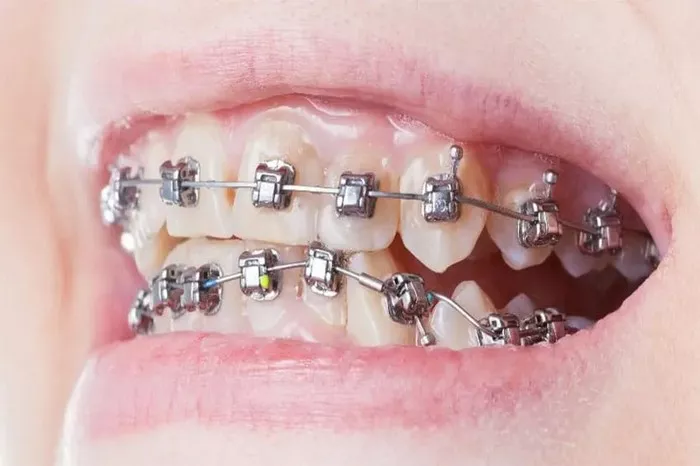Orthodontic treatment has come a long way over the years. One of the more modern innovations in the field is the self-ligating brace system. Unlike traditional braces that use elastic or metal ties to hold the archwire in place, self-ligating braces feature a built-in mechanism that clips the wire into the bracket. This design offers several advantages in terms of comfort, efficiency, and hygiene. In this article, we will delve into what self-ligating braces are, how they work, their benefits, drawbacks, and how they compare to other Braces Types.
What Are Self-Ligating Braces?
Self-ligating braces are orthodontic devices that use a specialized bracket with a built-in sliding mechanism to secure the archwire. This eliminates the need for elastic bands (ligatures). There are two main types of self-ligating brackets:
Passive self-ligating brackets: These have a simple sliding mechanism that reduces friction and allows for more natural tooth movement.
Active self-ligating brackets: These apply more pressure to the archwire for greater control over tooth movement.
Both types aim to make orthodontic treatment faster, more comfortable, and more efficient.
How Self-Ligating Braces Work
The brackets in self-ligating systems are designed to open and close like a door. Once the archwire is placed into the bracket slot, the clip is closed to hold it in place. This design allows the wire to move more freely within the bracket, reducing resistance and often resulting in shorter treatment times. The reduced friction also means that lighter forces can be used, which can translate to less discomfort for the patient.
Advantages of Self-Ligating Braces
There are several benefits to choosing self-ligating braces over traditional braces:
Shorter appointments: Without the need to change elastic bands, adjustment appointments are usually quicker.
Fewer visits: The reduced need for manual tightening often results in fewer orthodontic visits.
Improved hygiene: Elastic bands can trap food particles and plaque. Self-ligating systems eliminate this issue.
Greater comfort: Reduced pressure on teeth can lead to a more comfortable experience.
Faster results: In many cases, treatment can be completed in less time.
Disadvantages of Self-Ligating Braces
Despite their many benefits, self-ligating braces are not perfect. Here are a few drawbacks:
Higher cost: They can be more expensive than traditional braces. For more detailed information, refer to this guide on Braces Cost.
Aesthetic limitations: Although clear brackets are available, they are still more visible than clear aligners.
Limited availability: Not all orthodontists offer self-ligating options.
Comparing Self-Ligating Braces to Traditional Braces
Traditional braces use small elastic bands to hold the archwire in place, which increases friction and can lead to longer treatment times and more discomfort. Self-ligating braces, on the other hand, reduce friction and are often associated with quicker and more comfortable treatment.
However, traditional braces have been around for decades and are still a reliable and often more cost-effective solution for many patients. The choice between self-ligating and traditional braces often comes down to personal preference, orthodontic needs, and budget.
Types of Self-Ligating Braces
There are a few major brands of self-ligating braces, each with slightly different features:
Damon System: One of the most well-known self-ligating systems, featuring both metal and clear bracket options.
In-Ovation: Offers both active and passive bracket options and is known for its sleek design.
SmartClip: Utilizes a clip mechanism made of a nickel-titanium alloy for optimal force control.
These systems have been developed to provide enhanced comfort, reduced treatment time, and fewer office visits compared to traditional braces.
Ideal Candidates for Self-Ligating Braces
Self-ligating braces are suitable for a wide range of patients. They are particularly beneficial for those with:
- Crowded teeth
- Spacing issues
- Overbites or underbites
- Crossbites
- Open bites
However, a thorough evaluation by an orthodontist is essential to determine whether this option is the best for your specific needs.
Common Myths and Misconceptions
There are a few common misconceptions about self-ligating braces:
They are invisible: While they are less noticeable than traditional metal braces, they are not as discreet as clear aligners.
Treatment is always faster: Although often quicker, the actual treatment time depends on the complexity of the case.
No discomfort at all: While they may be more comfortable, some soreness is still expected.
Self-Ligating Braces vs. Clear Aligners
While clear aligners are an increasingly popular option, they are not suitable for all orthodontic cases. Self-ligating braces can treat more complex conditions and do not rely on patient compliance to the same extent as aligners, which must be worn 22+ hours a day to be effective.
Are Self-Ligating Braces Worth It?
Whether or not self-ligating braces are worth the extra cost depends on individual needs and preferences. Patients seeking shorter treatment times, fewer office visits, and potentially more comfort often find them a worthwhile investment. However, discussing all available options with an orthodontist is essential to make an informed decision.
Tips for Success During Treatment
To get the most out of your self-ligating braces treatment:
- Follow your orthodontist’s instructions
- Maintain excellent oral hygiene
- Attend all scheduled appointments
- Avoid hard, sticky, or sugary foods
- Wear any additional appliances or elastics as prescribed
Conclusion
Self-ligating braces represent a significant advancement in orthodontic technology. By eliminating the need for ligatures and utilizing a sliding mechanism, these braces offer faster treatment times, improved comfort, and easier maintenance. While they may cost more than traditional braces, many patients find the benefits worth the investment. Always consult with a qualified orthodontist to determine whether self-ligating braces are the best choice for your smile journey.
Related topics

